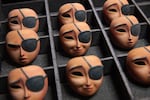You’re making a stop-motion animated film and you want your clay character to break into a big, warm, toothy smile. How do you do it?
In the old days, you’d get out your tools and carefully sculpt the mouth, frame by frame, until the smile looked just right.
But at LAIKA Animation Studio, in Hillsboro, Oregon, they've pioneered a new way to change facial expressions with 3-D printing.
For each of the characters in their films, LAIKA artists 3-D print hundreds, sometimes thousands, of different facial expressions. LAIKA’s groundbreaking animation technique won them an Academy Award just last year.

A tray of facial expressions for LAIKA character Kubo.
Courtesy of LAIKA
Brian McLean is LAIKA’s director of rapid prototype. For their latest film, "Kubo and the Two Strings," McLean said “Kubo, the character, has over 11,000 mouths. He's got over 4,000 different eyebrow expressions. And when you combine those eyebrow and mouth expressions together, he has over 48 million possible facial expressions. Which is far more than any other stop-motion animation character in history.”
When a LAIKA animator is shooting on the set of the film, “they have a puppet and a whole box of different facial expressions,” McLean said, “and they would very carefully remove the mouth, and then remove the eyebrow section, and they would grab a different expression … and they would replace that expression.” They shoot one frame, and then go through the whole process again. The result is a character with a believable facial expression that stays consistent throughout the film.
With over 11,000 mouths and 4,000 eyebrows, just with their lead character, LAIKA created a unique job on set: facial librarians. They track facial expressions with a kind of Dewey Decimal system using an intricate code printed on the back of each face.
“This number system allows the animators to know what face they're holding and what face they're putting on the character. But it also allows a whole army of facial librarians to know what shots these faces are needed for, and how many times they've been used in a particular shot,” McLean said.
For him, 3-D printing is just another way to make a great film.
“I think that's one of the most exciting things about working at LAIKA is that we are constantly trying to find new ways to tell stories, and evolve and improve upon our old methodologies," he said. "It creates a lot of sleepless nights, but it also makes it really exciting and fun to get up in the morning and come to work.”
